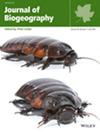Environmental features can act as selection pressures and barriers to gene flow between populations. The genetic structuring of highly mobile but philopatric seabirds creates a paradox, and the role of oceanographic and geographic variables is still poorly understood. In this study, we investigate the influence of environmental and geographic variables in the genetic and phenotypic diversity of a pantropical seabird breeding in islands and archipelagos separated by different geographic distances, up to thousand kilometres, and which differ in environmental characteristics.
Islands and archipelagos in the southwestern (SW) Atlantic Ocean.
Sula dactylatra, Lesson, 1831 (masked booby).
The population structure of the species was accessed through mitochondrial and nuclear DNA. To test Isolation by Environment (IBE) versus by Distance (IBD), sea surface temperature, primary productivity and salinity, as well as isotopic niche based on carbon and nitrogen, and distances between colonies and from the continent, were used. We also tested the correlation between the genetic structure and the morphometry of individuals in each colony.
We uncover the presence of low genetic structure between populations. Nevertheless, differences were identified between inshore and offshore colonies, with the influence of landscape characteristics of these two types of environment. The morphometric and isotopic niche variations are consistent with this segregation.
Environmental variables of coastal and oceanic environments seem to influence the genetic structure of masked boobies, even though it is low in the SW Atlantic Ocean, highlighting the role of environmental heterogeneity in shaping biodiversity.


